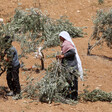Rights and Accountability 24 April 2024

Muhammad Jaber, known as Abu Shujaa, the leader of the Tulkarem Brigade militia in Nur Shams refugee camp, emerges among mourners after rumors of his killing in the northern occupied West Bank during a two-day military operation, on 21 April.
APA imagesThe Israeli military carried out bloody carnage and destruction at the Nur Shams refugee camp and surrounding areas in Tulkarem in the northern occupied West Bank during a two-day raid this week.
During the 54-hour operation, at least 14 Palestinians were killed by Israeli forces, including three children. The Israeli military carried out the operation with domestic intelligence agency Shin Bet and Israel’s Border Police. The invading forces damaged and destroyed homes, commercial stores, roads and other infrastructure, and left at least 25 Palestinians injured in the wake of the military raid.
“The Israeli military invasion into Nur Shams refugee camp marks the deadliest days in the occupied West Bank since the second intifada,” said Ayed Abu Eqtaish, accountability program director at Defense for Children International-Palestine.
On 18 April, more than 120 military vehicles carrying dozens of soldiers, Tel Aviv newspaper Haaretz reported, invaded the Nur Shams refugee camp from multiple entrances and checkpoints, including through the Avnei Hefetz settlement, located on the western edge of the northern West Bank near Tulkarem.
Israeli troops besieged the camp, as well as several homes within it. Israeli troops occupied several homes, turning some of them into “military bases, barracks and observation points,” according to DCIP.
Israeli military reinforcements, including three bulldozers, sealed the camp trapping residents inside, while others were unable to enter. Throughout the military raid, Israeli troops deliberately prevented ambulances from reaching wounded and killed Palestinians, DCIP reported.
The Israeli invasion resulted in widespread devastation.
“Bullets and grenades have left gaping holes in the walls of homes. Fragments of shells and LAU missiles are strewn across open spaces,” Haaretz reported.
Israeli bulldozers demolished infrastructure in the camp. Israeli forces damaged electricity, water, sewage systems, and telecommunication networks, leading to power outages during the military raid.
Footage of ambulances arriving at the refugee camp after the withdrawal of Israeli forces shows them having to traverse the rubble of destroyed roads amidst damaged infrastructure and battered streets.
“Citizens describe the camp’s condition as ‘Little Gaza,’ underscoring the extensive devastation caused by the occupation in just three days,” an analyst wrote in the Lebanese paper Al-Akhbar.This is part of transferring “the model of extermination seen in the Gaza Strip, and preceding it, with the ‘Dahiya Doctrine,’ as a method of action for the enemy army when confronting resistance in the West Bank.”
The “Dahiya Doctrine” is a strategy named after the southern suburb of Beirut that Israel deliberately flattened, where Israel indiscriminately targets civilian areas in order to turn civilians against armed resistance in the area and bring them to their knees.
In this strategy, the occupation forces “are not satisfied with confronting the resistance fighters, but rather seek to transform the camps into places unsuitable for life.”
Armed resistance
Armed Palestinians in the camp confronted the Israeli invaders to protect their community, injuring several Israeli soldiers.
Despite initial reports indicating that he was killed, the leader of the Tulkarem Brigade, a group associated with Saraya al-Quds, the military wing of the Islamic Jihad resistance group, emerged among mourners in the camp following the Israeli withdrawal.
Pictures circulating on social media show an armed Muhammad Jaber, known among residents in the camp as Abu Shujaa, being borne on the shoulders of a crowd of Palestinians.
“Our message is that we challenged the occupation, and here we are still alive,” Abu Shujaa told media following the military raid.Children killed
Three children were among those slaughtered in the massacre.
Jihad Nyaz Naser Zandiq, a 15-year-old, was at home with his uncle when a group of armed Palestinians reportedly arrived on 19 April.
Israeli troops surrounded the house and ordered all its occupants to come out.
Despite Jihad and another Palestinian man exiting the house with their hands raised and declaring they were civilians, Israeli forces still opened fire, fatally shooting both of them.
Jihad’s body remained on the ground for 17 hours before a neighbor moved him into his house until Israeli forces withdrew from the camp, DCIP reported.
A 17-year-old boy was hit by shrapnel from an Israeli-fired shell on the same day.
Ali Mohammad Ali Abdullah, who allegedly participated in confronting the invading Israeli troops, was attempting to leave a neighborhood of the camp with another young man when he was struck.
He sustained burns and shrapnel wounds on his face and body, and his corpse remained on the ground until Israeli forces withdrew from the area, DCIP’s field investigation found.
An Israeli soldier, stationed in a heavily armored military vehicle, fatally shot a 14-year-old boy who was standing with a group of civilians at a roundabout in Tulkarem.
There were no confrontations between armed Palestinians and Israeli forces at the time, according to DCIP’s field investigation.
The soldier fired a bullet at Qais Fathi Ibrahim Nasrullah from a distance of 300 meters, striking him in the chest, according to DCIP.
Although the boy was rushed to the hospital by a private vehicle, he was pronounced dead minutes after arrival, despite efforts to resuscitate him.
Genocide alert
“Israel has employed a lethal open-fire policy in the West Bank” since 7 October, Israeli human rights group B’Tselem said.
The Lemkin Institute for Genocide Prevention issued an “active genocide alert” over the situation for Palestinians in the occupied West Bank, declaring that “Israel is committing genocide against Palestinians across Palestine.”
Earlier this month, violence against Palestinians in the West Bank accelerated as large groups of Israeli settler mobs launched attacks on more than a dozen Palestinian villages following the disappearance of an Israeli teenager.
Amnesty International highlighted an “alarming spike in violence” perpetrated by Jewish settlers against Palestinians in the occupied West Bank. The organization emphasized “the urgent need to dismantle illegal settlements, end Israel’s occupation” and its system of apartheid.
The human rights organization implicitly rejected attempts to portray these attacks as isolated incidents caused by a few bad apples, as state sanctions against a handful of extremist settlers suggested.
“The appalling spike in settler violence against Palestinians in recent days is part of a decades-long state-backed campaign to dispossess, displace and oppress Palestinians in the occupied West Bank, including East Jerusalem, under Israel’s system of apartheid,” said Heba Morayef, Regional Director for the Middle East and North Africa at Amnesty International.
“Violence is integral to the establishment and expansion of these settlements and to sustaining apartheid,” she added.
“It’s time for the world to recognize this and pressure Israeli authorities to abide by international law by immediately halting settlement expansion and removing all existing settlements.”




